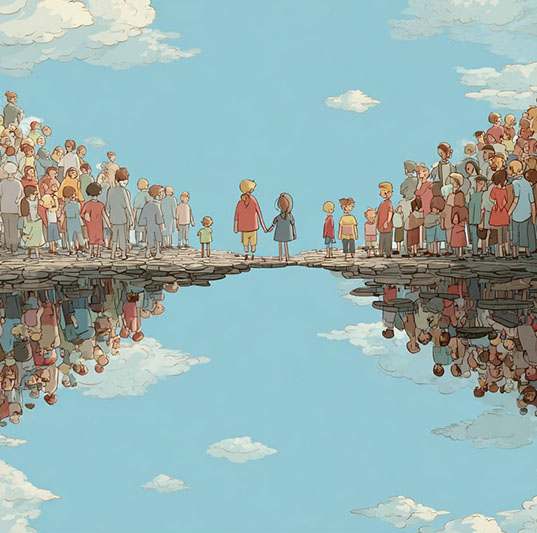In June 2025, the world’s population is set to surpass 8.229 billion, according to UN estimates. But what if that figure is not entirely accurate? A recent study suggests the actual number could be hundreds of millions higher, particularly in rural regions of the Global South where census data is incomplete or entirely missing.
Beyond the raw numbers, global demography is full of contrasts, paradoxes and striking statistics. From cities with populations greater than entire countries to remote villages with a single resident, the human map of the planet is as surprising as it is complex. Here are some fascinating facts that might challenge your assumptions.
How many people are there really? The population count debate
The global headcount may not be what official data tells us. Researchers at Aalto University in Finland suggest that rural populations are being significantly undercounted—by up to 84% in some areas. The main reason lies in the limitations of census methods and satellite data, particularly in remote or difficult-to-access regions.
These gaps in data have major implications for infrastructure development, healthcare planning and public policy. Emerging technologies such as big data, artificial intelligence, and the use of cross-referenced indicators—like satellite imagery of farmland or emissions tracking—could offer a more accurate picture of the world's population landscape.
Some studies suggest rural populations may be undercounted by as much as 84%.
Asia: The human epicentre of the planet
Some facts, however, are well established. Asia is home to nearly 60% of the global population—more than 4.8 billion people in 2025. India leads with 1.463 billion inhabitants, followed closely by China with 1.416 billion.
This demographic dominance is nothing new: many of history’s most influential civilisations emerged in Asia, dating back to the Fertile Crescent. Still, population trends vary widely across the continent. While Asia continues to grow, Europe faces stagnation, with a near-zero growth rate.
Asia is home to 60% of the global population, with India and China at the forefront.
Tokyo: the megacity that overshadows countries
Tokyo, Japan, remains the world’s most populous urban area, with over 37 million residents in its greater metropolitan region. For context, that is more than the total population of countries like Canada or Poland.
This is part of a wider global trend towards urbanisation. By 2025, an estimated 58% of the world’s population will be living in cities.
Tokyo has over 37 million residents—more than many entire nations.
The paradox of declining fertility
Despite overall population growth, the global fertility rate has dropped from five children per woman in the 1960s to just 2.2 in 2025. In India, the rate has already fallen below the replacement threshold, raising concerns about population ageing and long-term economic sustainability.
fallen below the replacement threshold, raising concerns about population ageing and long-term economic sustainability.
This trend is mirrored in Europe and other parts of the world, where low birth rates are prompting discussions about migration and labour shortages. These demographic imbalances point to the need for international cooperation in managing migration flows.
By 2025, the global fertility rate will have declined to 2.2 children per woman.
From megacities to ghost towns: demographic extremes
While some urban centres house tens of millions, there are municipalities with only a single resident. These extremes highlight stark inequalities in population distribution and raise pressing questions about the viability of certain rural areas.
To manage population growth more sustainably, it will be vital to revitalise depopulated rural regions—economically and socially—so that settlement patterns become more balanced.
Looking to the future: Where are we headed?
Demographic forecasts suggest that the global population will peak around the year 2080 at approximately 10.4 billion before beginning a gradual decline. This shift will be shaped by factors such as urbanisation, ageing societies, and migration policies.
In this context, promoting sustainability and social equity will be key to addressing the demographic challenges ahead.
Global population is expected to peak in 2080 at around 10.4 billion people.
How many is too many?
Discussions around overpopulation often veer into alarmism. But the real issue may not be how many people there are, but rather how we live together—and how we coexist with the planet. According to a 2020 study published in Nature Sustainability, it would be possible to feed more than ten billion people without crossing environmental limits. However, this would require major changes in farming methods, dietary habits and consumption patterns.
Conclusion: Beyond the numbers
Demography is more than statistics—it is a reflection of how we live, move and share space on a finite planet. Understanding these population dynamics is crucial for building a fairer, more sustainable world.
One of the most immediate concerns linked to population growth is environmental sustainability. Clean water, food and air are essential not only for people, but for all life on Earth. To reduce the environmental impact of human expansion, it is critical to promote balanced development policies and invest in technologies that improve energy efficiency and lower emissions.
Better crop management and production systems will be essential—but so too will new approaches to urban planning. Sustainable mobility, regenerative infrastructure, and solutions like the floodable parks we reported on recently will all help make cities more liveable and resilient.
Sources:
Journalist and content manager specialising in sustainability. Trained at the Carlos III University of Madrid, she works at the intersection between the environmental, the human and the organisational from a conscious and committed point of view.
Her texts seek to provide clarity and perspective, integrating a critical, conscious and documented look at the challenges of the present.
Collaborates in
Sustainability for allSpecializing in
Climate change
Sustainability
Environment